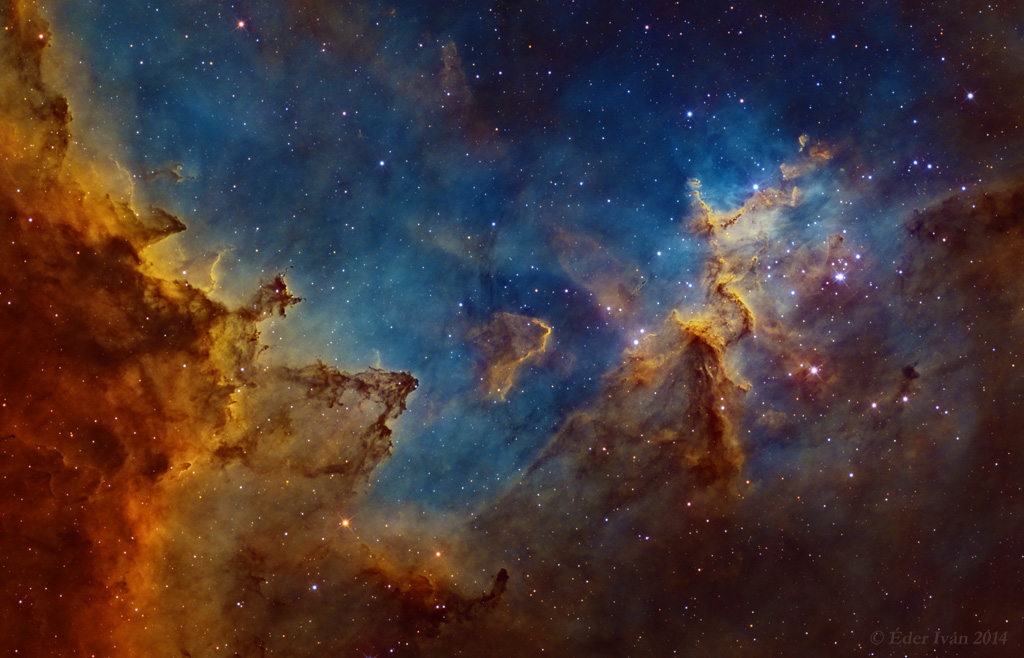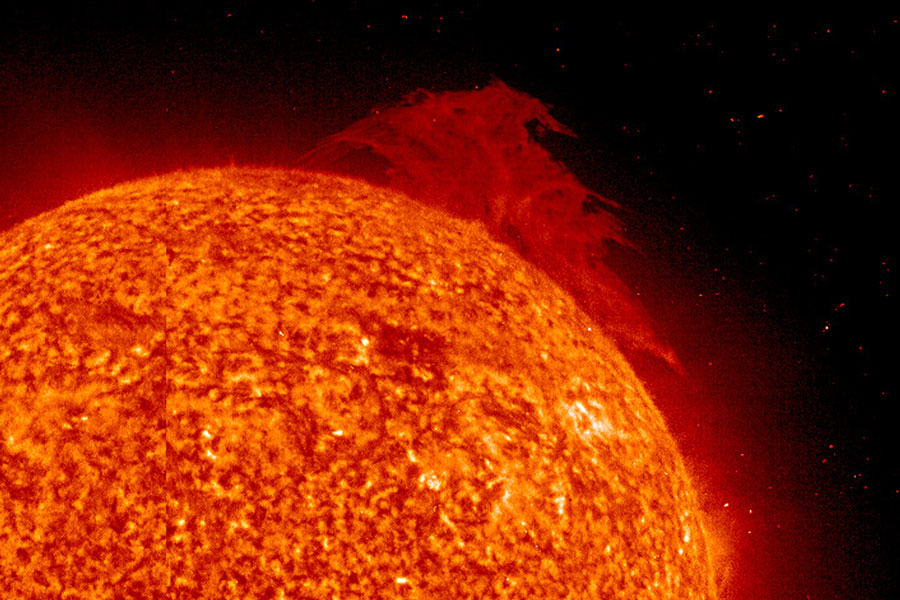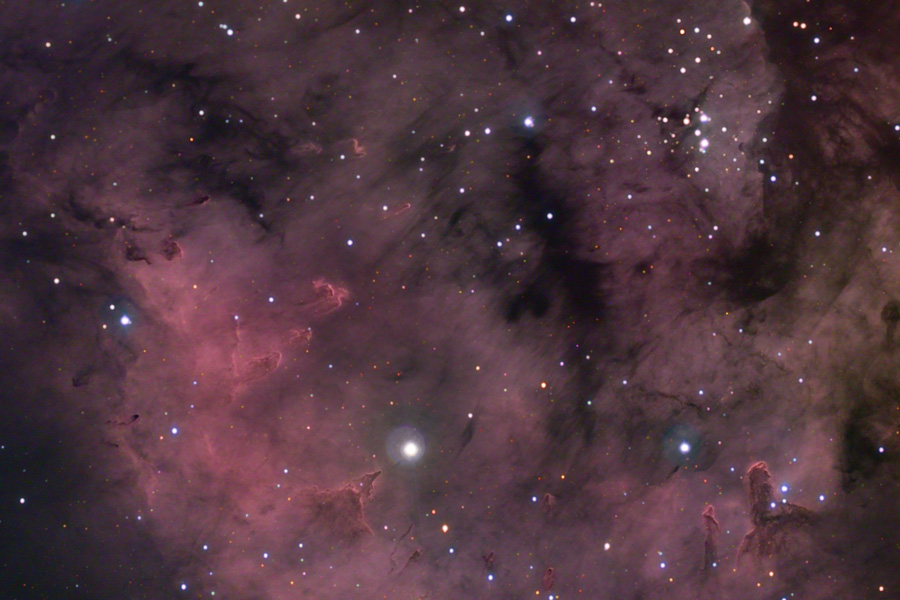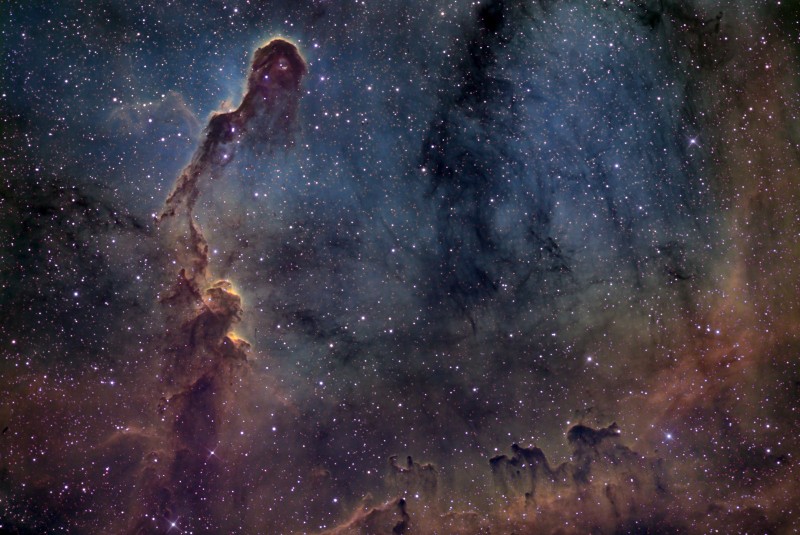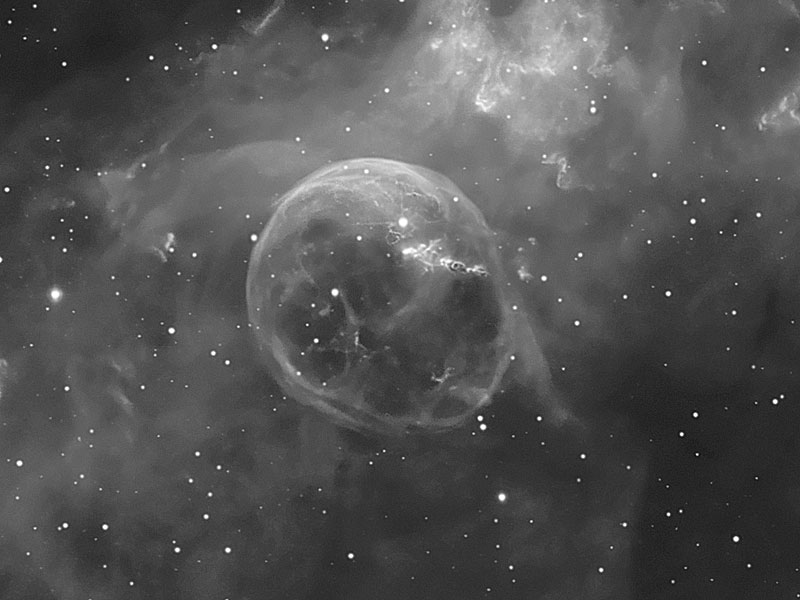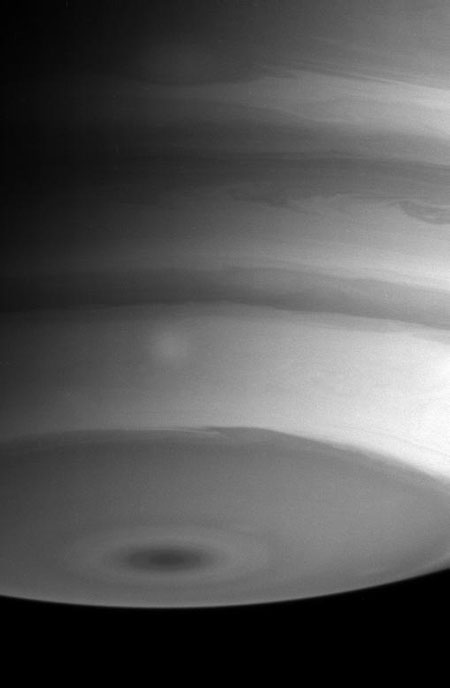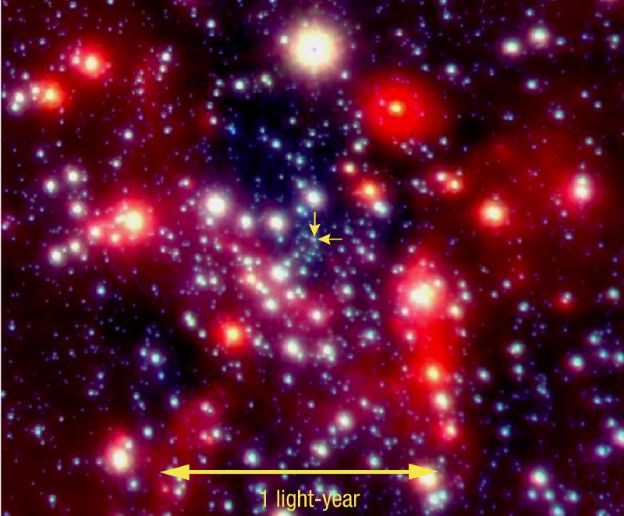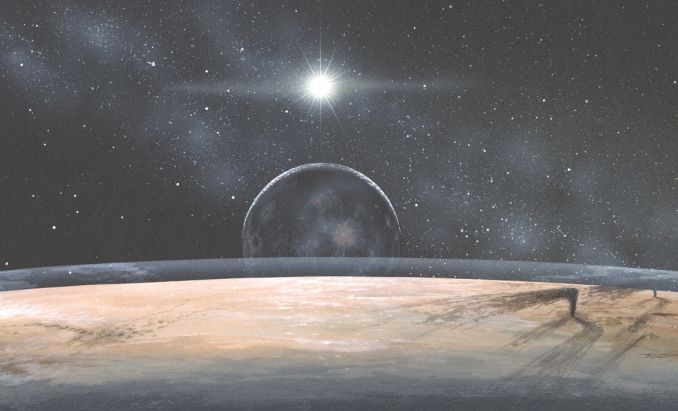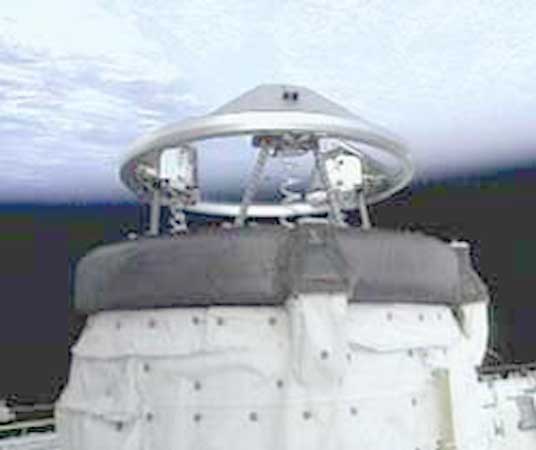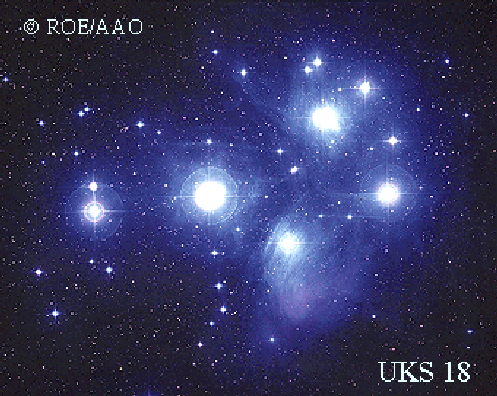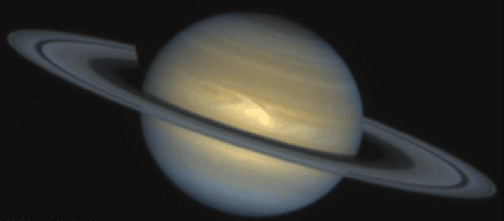| << Previous | Index | Next >> |
2014 Cosmic clouds form fantastic shapes in the central regions of emission nebula IC 1805. The clouds are sculpted by stellar winds and radiation from massive hot stars in the nebula's newborn star cluster, Melotte 15. About 1.5 million years young, the cluster stars are toward the right in this colorful skyscape, along with dark dust clouds in silhouette against glowing atomic gas. A composite of narrowband and broadband telescopic images, the view spans about 30 light-years and includes emission from ionized hydrogen, sulfur, and oxygen atoms mapped to green, red, and blue hues in the popular Hubble Palette. Wider field images reveal that IC 1805's simpler, overall outline suggests its popular name - The Heart Nebula. IC 1805 is located about 7,500 light years away toward the boastful constellation Cassiopeia.
2013 The bulging center of our Milky Way Galaxy rests on a pillar of light in this luminous skyscape. Recorded on September 22nd in dark South African skies, rivers of dust seem to flow downward from the galactic center towards Antares, yellowish alpha star of the constellation Scorpius, near the top of the scene. The brightest celestial beacon present is not a star at all though, but planet Venus, still dominant in the western sky after sunset. Of course, the pillar of light stretching upward from the horizon is Zodiacal light. Sunlight scattered by dust along the plane of the ecliptic creates the zodiacal glow, prominent in the evening after twilight during the southern hemisphere spring.
2012
[imghover6=http://www.eso.org/public/archives/imag ... o1241a.jpg]http://www.eso.org/public/archives/imag ... o1241b.jpg[/imghover6]Illustration Credit: European Southern Observatory, L. Calçada, N. Risinger (skysurvey.org)
2011
Click to play embedded YouTube video.
Image Credit & Copyright: Antony Searle & Craig Savage (ANU)
2010 What's that coming over the edge of the Sun? What might appear at first glance to be some sort of Sun monster is actually a solar prominence. The above prominence, captured by the Sun-orbiting SOHO satellite earlier this year during an early stage of its eruption, rapidly became one of the largest ever on record. Even as pictured, the prominence is huge -- the Earth would easily fit inside. A solar prominence is a thin cloud of solar gas held just above the surface by the Sun's magnetic field. A quiescent prominence typically lasts about a month, while an eruptive prominence like the one developing above may erupt within hours into a Coronal Mass Ejection (CME), expelling hot gas into the Solar System. Although very hot, prominences typically appear dark when viewed against the Sun, since they are slightly cooler than the surface. As our Sun evolves toward Solar maximum over the next three years, more large eruptive prominences are expected.
2009 Towering pillars of cold gas and dark dust adorn the center star forming region of Sharpless 171. An open cluster of stars is forming there from the gas in cold molecular clouds. As energetic light emitted by young massive stars boils away the opaque dust, the region fragments and picturesque pillars of the remnant gas and dust form and slowly evaporate. The energetic light also illuminates the surrounding hydrogen gas, causing it to glow as a red emission nebula. Pictured above is the active central region of the Sharpless 171 greater emission nebula. Sharpless 171 incorporates NGC 7822 and the active region Cederblad 214, much of which is imaged above. The area above spans about 20 light years, lies about 3,000 light years away, and can be seen with a telescope toward the northern constellation of the King of Ethiopia (Cepheus).
2008 Cosmic pillars of cold molecular gas and clouds of dark dust lie within Sharpless 171, a star-forming region some 3,000 light-years away in the royal constellation Cepheus. This tantalizing false-color skyscape spans about 20 light-years across the nebula's bright central region. It also highlights the pervasive glow of emission from atomic gas using narrowband filters and a color palette made popular in Hubble Space Telescope images. Powering the nebular glow are the young, hot stars of a newly formed cluster, Berkeley 59. Of course, this star-forming region is entry number 171 in the famous 1959 catalog of emission nebulae compiled by astronomer Stewart Sharpless.
2007 Like an illustration in a galactic Just So Story, the Elephant's Trunk Nebula winds through the emission nebula and young star cluster complex IC 1396, in the high and far off constellation of Cepheus. Of course, this cosmic elephant's trunk is over 20 light-years long. The false-color view was recorded through narrow band filters that transmit the light from hydrogen (in green), sulfur (in red), and oxygen (in blue) atoms in the region. The resulting composite highlights the bright swept-back ridges that outline pockets of cool interstellar dust and gas. Such embedded, dark, tendril-shaped clouds contain the raw material for star formation and hide protostars within the obscuring cosmic dust. Nearly 3,000 light-years distant, the relatively faint IC 1396 complex covers a large region on the sky, spanning about 5 degrees. This dramatic close-up covers a 1/2 degree wide field, about the size of the Full Moon.
2006 What created this huge space bubble? Blown by the wind from a star, this tantalizing, ghostly apparition is cataloged as NGC 7635, but known simply as The Bubble Nebula. Astronomer Eric Mouquet's striking view utilizes a long exposure with hydrogen alpha light to reveal the intricate details of this cosmic bubble and its environment. Although it looks delicate, the 10 light-year diameter bubble offers evidence of violent processes at work. Seen here above and right of the Bubble's center is a bright hot star embedded in reflecting dust. A fierce stellar wind and intense radiation from the star, which likely has a mass 10 to 20 times that of the Sun, has blasted out the structure of glowing gas against denser material in a surrounding molecular cloud. The intriguing Bubble Nebula lies a mere 11,000 light-years away toward the boastful constellation Cassiopeia.
2005 Is star AE Aurigae on fire? No. Even though AE Aurigae is named the flaming star, the surrounding nebula IC 405 is named the Flaming Star Nebula, and the region appears to harbor red smoke, there is no fire. Fire, typically defined as the rapid molecular acquisition of oxygen, happens only when sufficient oxygen is present and is not important in such high-energy, low-oxygen environments such as stars. The material that appears as smoke is mostly interstellar hydrogen, but does contain smoke-like dark filaments of carbon-rich dust grains. The bright star AE Aurigae, visible just below the image center, is so hot it is blue, emitting light so energetic it knocks electrons away from surrounding gas. When a proton recaptures an electron, red light is frequently emitted, as seen in the surrounding emission nebula. Pictured above, the Flaming Star nebula lies about 1,500 light years distant, spans about 5 light years, and is visible with a small telescope toward the constellation of the Charioteer (Auriga).
2004 What happens to Saturn's pervasive clouds at its South Pole? Visible in the above image of Saturn are bright bands, dark belts and a dark spot right over the South Pole. The above image in infrared light spans over 30,000 kilometers and was taken early last month by the robot Cassini spacecraft currently orbiting Saturn. Saturn's atmosphere is about 75 percent hydrogen, 25 percent helium, and small amounts of heavier compounds including water vapor, methane, and ammonia. The relatively low gravity at Saturn's cloud tops result in a thicker haze layer, which in turn makes atmospheric features blurrier than Jupiter.
2003 In 1865 Jules Verne predicted the invention of a space capsule that could carry people. In his science fiction story "From the Earth to the Moon", he outlined his vision of a cannon in Florida so powerful that it could shoot a "Projectile-Vehicle" carrying three adventurers to the Moon. Over 100 years later, NASA, guided by Wernher Von Braun's vision, produced the Saturn V rocket. From a spaceport in Florida, this rocket turned Verne's fiction into fact, launching 9 Apollo Lunar missions and allowing 12 astronauts to walk on the Moon. Pictured is the last moon shot, Apollo 17, awaiting its December 1972 night launch. Spotlights play on the rocket and launch pad at dusk. Humans have not walked on on the lunar surface since.
2002 At the center of our Milky Way Galaxy lies a black hole with over 2 million times the mass of the Sun. Once a controversial claim, this astounding conclusion is now virtually inescapable and based on observations of stars orbiting very near the galactic center. Using one of the Paranal Observatory's very large telescopes and the sophisticated infrared camera NACO, astronomers patiently followed the orbit of a particular star, designated S2, as it came within about 17 light-hours of the center of the Milky Way (17 light-hours is only about 3 times the radius of Pluto's orbit). Their results convincingly show that S2 is moving under the influence of the enormous gravity of an unseen object which must be extremely compact -- a supermassive black hole. This deep NACO near-infrared image shows the crowded inner 2 light-years of the Milky Way with the exact position of the galactic center indicated by arrows. NACO's ability to track stars so close to the galactic center can accurately measure the black hole's mass and perhaps even provide an unprecedented test of Einstein's theory of gravity as astronomers watch a star orbit a supermassive black hole.
2001 Pluto's horizon spans the foreground in this artist's vision, gazing sunward across that distant and not yet explored world. Titled New Horizons, the painting also depicts Pluto's companion, Charon, as a darkened, ghostly apparition with a luminous crescent against a starry background. Beyond Charon, the diminished Sun is immersed in a flattened cloud of zodiacal dust. Here, Pluto's ruddy colors are based on existing astronomical observations while imagined but scientifically tenable details provided by the artist include high atmospheric cirrus and dark plumes from surface vents, in analogy to Neptune's large moon Triton explored by the Voyager 2 spacecraft in 1989. Craters suggest bombardment by Kuiper Belt objects, a newly understood population of outer solar system bodies likely related to the Pluto-Charon system. NASA is now considering a future robotic reconnaissance mission to Pluto-Charon and the Kuiper Belt which could reach the distant worlds late in the next decade.
2000 A space shuttle is again visiting the International Space Station (ISS). The STS-92 crew aboard Discovery have already delivered and installed a truss and a docking port on the growing orbiting space station. The station is being prepared for its first permanent crew, currently scheduled to be launched from Kazakstan on October 30. Pictured above, the shuttle's docking ring is being extended to enable a stable connection to the space station.
1999 NGC 3603 is home to a massive star cluster, thick dust pillars, and a star about to explode. The central open cluster contains about 2000 bright stars, each of which is much brighter and more massive than our Sun. Together, radiations from these stars are energizing and pushing away surrounding material, making NGC 3603 one of the most interesting HII regions known. NGC 3603 is about 20,000 light-years away, and the region shown is about 20 light-years across. Possibly most interesting about this recently released, representative-color picture are the large number of dim stars visible. These stars are less massive than our Sun, demonstrating that great numbers of low-mass stars also form in active starburst regions.
1998 Saturn's rings are actually very thin. This picture from the Hubble Space Telescope was taken on August 6, 1995 when the rings lined up sideways as seen from Earth. Saturn's largest moon Titan is seen on the left, and Titan's shadow can be seen on Saturn's cloud tops! Titan itself looks a brownish color because of its thick atmosphere. Four other moons of Saturn can be seen just above the ring plane, which are, from left to right: Mimas, Tethys, Janus, and Enceladus. If you look carefully, you will note that the dark band across the planet is actually the shadow of the rings, and is slightly displaced from the real rings - which are best seen away from the planet. Saturn's rings are not solid - they are composed of ice chunks which range in size from a grain of sand to a house.
1997 It is the most famous star cluster on the sky. The Pleiades can be seen without binoculars from even the depths of a light-polluted city. Also known as the Seven Sisters and M45, the Pleiades is one of the brightest and closest open clusters. The Pleiades contains over 3000 stars, is about 400 light years away, and only 13 light years across. Quite evident in the above photograph are the blue reflection nebulae that surround the bright cluster stars. Low mass, faint, brown dwarfs have recently been found in the Pleiades.
1996 Auroras are especially large on Jupiter. In pictures released yesterday, the Hubble Space Telescope imaged these unusual light displays in more detail than ever before. Jupiter's auroras are linked to its volcanic moon Io. Io's volcanoes release particles, some of which become ionized, trapped by Jupiter's magnetic field, and rain down on the gas giant. The resulting auroral displays may be thousands of times brighter than any auroral display on Earth, and involve unusual spots. The above pictures show how the extended auroral emissions rotate with Jupiter, while the auroral spots stay synchronized to Io as it circles Jupiter.
1995 The white wisp shown on Saturn's cloud tops is actually a major storm system only discovered in December of 1994. Saturn's clouds are composed of primarily hydrogen and helium, but the storm's white clouds are actually ammonia ice crystals that have frozen upon upheaval to the top of the atmosphere. The storm may look small but has an extent similar to the diameter of the Earth. This picture is a color composite of several taken by the Hubble Space Telescope. Saturn is the second largest planet in the Solar System and has the most elaborate ring system.
| << Previous | Index | Next >> |
